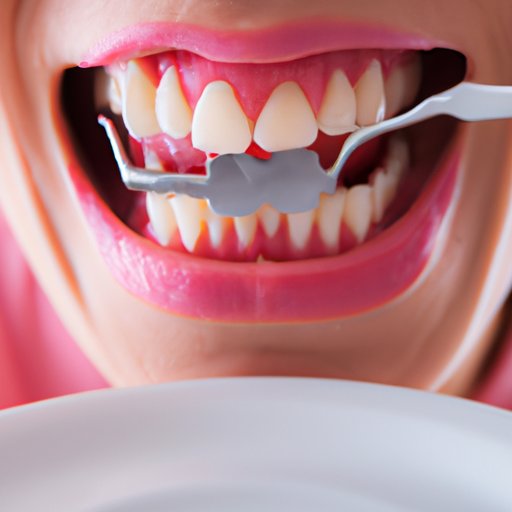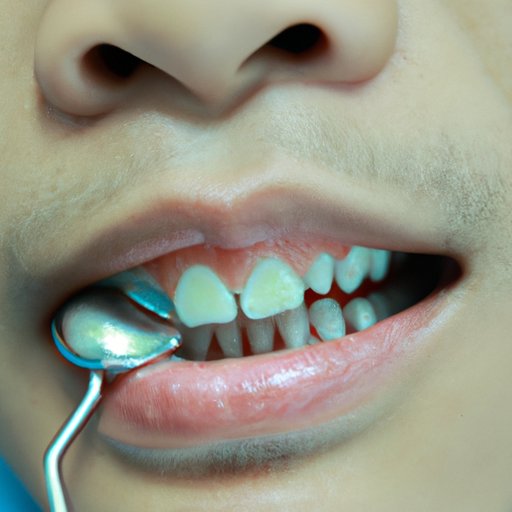Introduction
Having a dental filling is an important part of maintaining good oral health. But when it comes to eating after a dental filling, there can be some confusion about what is safe and what isn’t. This article will explore the risks and benefits of waiting to eat after a dental filling, as well as provide advice from dentists on how long to wait and what foods to avoid or consume.

Exploring the Risks of Eating Too Soon After a Dental Filling
When it comes to eating after a dental filling, there are certain risks that you should be aware of. Immediate consumption of food after a dental filling can cause the filling to become dislodged or damaged. This can lead to further damage to your teeth and gums, as well as increased pain and discomfort. In addition, eating too soon after a dental filling can increase your risk of infection, as food particles can get stuck in the newly-filled cavity.
In addition to these risks, there are potential complications associated with eating too soon after a dental filling. For example, if the filling was placed near a nerve, eating too soon after the procedure could cause the nerve to become irritated. This can result in pain, numbness, and tingling in the affected area. It is also possible that eating too soon after a dental filling could cause the filling material to become weakened and eventually fall out.
How Long Should You Wait to Eat After a Dental Filling?
The amount of time you should wait to eat after a dental filling will depend on several factors, such as the type of filling used and the location of the filling. Generally speaking, however, dentists recommend waiting at least 30 minutes to an hour before eating after a dental filling. This allows the filling material to set properly and reduces the risk of damage or irritation.
Your dentist may also give you specific instructions on when it is safe to eat after a dental filling. For instance, they may advise you to wait longer than an hour if the filling was located close to a nerve or in an area that is more prone to movement. In any case, it is best to follow your dentist’s instructions to ensure the best outcome.
What Foods Can You Eat After a Dental Filling?
When it comes to eating after a dental filling, it is important to choose soft foods that won’t irritate or damage the filling. Soft fruits, cooked vegetables, and yogurt are all good options. You should also avoid crunchy, sticky, or hard foods, such as chips, nuts, and candy, as these can damage the filling or cause it to become dislodged.
In addition, you should avoid hot or acidic foods and drinks, such as coffee or tea, as these can irritate the filling and the surrounding tissue. If you do decide to consume hot or acidic foods and drinks, make sure they have cooled down before consuming them.
Tips for Eating Comfortably After a Dental Filling
Eating after a dental filling can be uncomfortable, especially if the filling is located near a nerve. To reduce discomfort while eating, try taking smaller bites and chewing slowly. You should also avoid biting directly on the filling, as this can cause pain and irritation. Additionally, you may want to try using a straw to drink cold beverages, as this can help reduce pain and swelling.
Finally, you should make sure that you are brushing and flossing regularly after a dental filling to keep the area clean and free from food particles. This can help reduce the risk of infection and ensure that the filling stays in place.

Understanding the Benefits of Waiting to Eat After a Dental Filling
Although it can be tempting to eat immediately after a dental filling, taking the time to wait can offer many benefits. By waiting to eat, you can reduce the risk of damaging or irritating the filling or the surrounding tissue. Additionally, waiting to eat can help ensure that the filling sets properly, which can help it last longer. Finally, by taking the time to wait before eating, you can reduce the risk of infection and other complications.
Conclusion
Eating after a dental filling can be confusing and uncomfortable, but understanding the risks and benefits of waiting to eat can help you make the best decision for your oral health. Generally speaking, dentists recommend waiting at least 30 minutes to an hour before eating after a dental filling. When it comes to what to eat, soft foods are recommended, while avoiding hot, acidic, crunchy, sticky, or hard foods. Taking care when eating after a dental filling can help ensure that the filling lasts longer and that any risks or complications are minimized.
By following the advice in this article, you can take the necessary steps to ensure that you are eating safely and comfortably after a dental filling. Remember, it is always best to follow your dentist’s instructions to ensure the best outcome.
(Note: Is this article not meeting your expectations? Do you have knowledge or insights to share? Unlock new opportunities and expand your reach by joining our authors team. Click Registration to join us and share your expertise with our readers.)
